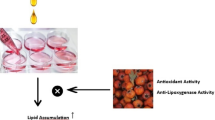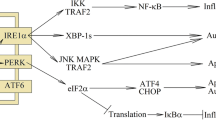Abstract
Objective
To investigate the effects of berberine (BBR) and cinnamic acid (CA), the main active components in Jiaotai Pill (交泰丸, JTP), on palmitic acid (PA)-induced intracellular triglyceride (TG) accumulation in NIT-1 pancreatic β cells.
Methods
Cells were incubated in culture medium containing PA (0.25 mmol/L) for 24 h. Then treatments with BBR (10 μmol/L), CA (100 μmol/L) and the combination of BBR and CA (BBR+CA) were performed respectively. Intracellular lipid accumulation was assessed by Oil Red O staining and TG content was measured by colorimetric assay. The expression of adenosine monophosphate-activated protein kinase (AMPK) protein and its downstream lipogenic and fatty acid oxidation genes, including fatty acid synthase (FAS), acetyl-coA carboxylase (ACC), phosphorylation acetyl-coA carboxylase (pACC), carnitine acyl transferase 1 (CPT-1) and sterol regulating element binding protein 1c (SREBP-1c) were determined by Western blot or real time polymerase chain reaction.
Results
PA induced an obvious lipid accumulation and a significant increase in intracellular TG content in NIT-1 cells. PA also induced a remarkable decrease in AMPK protein expression and its downstream targets such as pACC and CPT-1. Meanwhile, AMPK downstream lipogenic genes including SREBP-1c mRNA, FAS and ACC protein expressions were increased. Treatments with BBR and BBR+CA, superior to CA, significantly reversed the above genes changes in NIT-1 pancreatic β cells. However, the synergistic effect of BBR and CA on intracellular TG content was not observed in the present study.
Conclusion
It can be concluded that in vitro, BBR and BBR+CA could inhibit PA-induced lipid accumulation by decreasing lipogenesis and increasing lipid oxidation in NIT-1 pancreatic β cells.
Similar content being viewed by others
References
Zhou YP, Grill VE. Long-term exposure of rat pancreatic islets to fatty acids inhibits glucose-induced insulin secretion and biosynthesis through a glucose fatty acid cycle. J Clin Invest 1994;93:870–876.
Piro S, Anello M, Di Pietro C, Lizzio MN, Patane G, Rabuazzo AM, et al. Chronic exposure to free fatty acids or high glucose induces apoptosis in rat pancreatic islets: possible role of oxidative stress. Metabolism 2002;51:1340–1347.
Kharroubi I, Ladriere L, Cardozo AK, Dogusan Z, Cnop M, Eizirik DL. Free fatty acids and cytokines induce pancreatic beta-cell apoptosis by different mechanisms: role of nuclear factor-kappaB and endoplasmic reticulum stress. Endocrinology 2004;145:5087–5096.
Shimabukuro M, Higa M, Zhou YT, Wang MY, Newgard CB, Unger RH. Lipoapoptosis in beta-cells of obese prediabetic fa/fa rats. Role of serine palmitoyltransferase overexpression. J Biol Chem 1998;273:32487–32490.
Costes S, Langen R, Gurlo T, Matveyenko AV, Butler PC. Beta-Cell failure in type 2 diabetes: a case of asking too much of too few? Diabetes 2013;62:327–335.
Wan J, Jiang L, Lü Q, Ke L, Li X, Tong N. Activation of PPAR δ up-regulates fatty acid oxidation and energy uncoupling genes of mitochondria and reduces palmitateinduced apoptosis in pancreatic β-cells. Biochem Biophys Res Communic 2010;391:1567–1572.
Xie W, Zhao Y, Du L. Emerging approaches of traditional Chinese medicine formulas for the treatment of hyperlipidemia. J Ethnopharmacol 2012;140:345–367.
Zhen Z, Chang B, Li M, Lian FM, Chen L, Dong L, et al. Anti-diabetic effects of a Coptis chinensis containing new traditional Chinese medicine formula in type 2 diabetic rats. Am J Chin Med 2011;39:53–63.
Khan A, Safdar M, Ali Khan MM, Khattak KN, Anderson RA. Cinnamon improves glucose and lipids of people with type 2 diabetes. Diabetes Care 2003;26:3215–3218.
Yokozawa T, Ishida A, Cho EJ, Nakagawa T. The effects of Coptidis Rhizoma extract on a hypercholesterolemic animal model. Phytomedicine 2003;10:17–22.
Baker WL, Gutierrez-Williams G, White CM, Kluger J, Coleman CI. Effect of cinnamon on glucose control and lipid parameters. Diabetes Care 2008;31:41–43.
Ping H, Zhang G, Ren G. Antidiabetic effects of cinnamon oil in diabetic KK-Ay mice. Food Chem Toxicol 2010;48:2344–2349.
Zou X, Liu DL, Lu FE, Dong H, Xu LJ, Luo YH, et al. The effect of Jiaotaiwan on pancreatic lipid accumulation and islet cell apoptosis in a rat model of type 2 diabetes. China Chin Mater Med (Chin) 2014 (in press)
Huang ZY, Xu XH, Lu FE, Wang N, Chen G, Zhao Y, et al. Jiao Tai Wan attenuates hepatic lipid accumulation in type 2 diabetes mellitus. Evid Based Complement Alternat Med 2013;2013:567045.
Gao N, Zhao TY, Li XJ. The protective effect of berberine on beta-cell lipoapoptosis. J Endocrinol Invest 2011;34:124–130.
Shen N, Huan Y, Shen ZF. Berberine inhibits mouse insulin gene promoter through activation of AMP activated protein kinase and may exert beneficial effect on pancreatic betacell. Eur J Pharmacol 2012;694:120–126.
Zhou L, Wang X, Shao L, Yang Y, Shang W, Yuan G, et al. Berberine acutely inhibits insulin secretion from beta-cells through 3’,5’-cyclic adenosine 5’-monophosphate signaling pathway. Endocrinology 2008;149:4510–4518.
Adisakwattana S, Moonsan P, Yibchok-Anun S. Insulinreleasing properties of a series of cinnamic acid derivatives in vitro and in vivo. J Agric Food Chem 2008; 56:7838–7844.
Zang M, Zuccollo A, Hou X, Nagata D, Walsh K, Herscovitz H, et al. AMP-activated protein kinase is required for the lipid-lowering effect of metformin in insulin-resistant human HepG2 cells. J Biol Chem 2004;279:47898–47905.
Hou X, Xu S, Maitland-Toolan KA, Sato K, Jiang B, Ido Y, et al. SIRT1 regulates hepatocyte lipid metabolism through activating AMP-activated protein kinase. J Biol Chem 2008;283:20015–20026.
Zang M, Xu S, Maitland-Toolan KA, Zuccollo A, Hou X, Jiang B, et al. Polyphenols stimulate AMP-activated protein kinase, lower lipids, and inhibit accelerated atherosclerosis in diabetic LDL receptor-deficient mice. Diabetes 2006;55:2180–2191.
van Herpen NA, Schrauwen-Hinderling VB. Lipid accumulation in non-adipose tissue and lipotoxicity. Physiol Behav 2008;94:231–241.
Snel M, Jonker JT, Schoones J, Lamb H, de Roos A, Pijl H, et al. Ectopic fat and insulin resistance: pathophysiology and effect of diet and lifestyle interventions. Int J Endocrinol; 2012:983814.
van Raalte DH, van der Zijl NJ, Diamant M. Pancreatic steatosis in humans: cause or marker of lipotoxicity? Curr Opin Clin Nutr Metab Care 2010;13:478–485.
Gong YL, Lu FE, Dong H. Effects of Jiaotai Pill and its single components on ectopic fat accumulation in rats with type 2 diabetes mellitus. Chin J Integr Tradit West Med (Chin) 2010;30:1297–1301.
Dong H, Wang JH, Lu FE, Xu LJ, Gong YL, Zou X. Jiaotai Pill enhances insulin signaling through phosphatidylinositol 3-kinase pathway in skeletal muscle of diabetic rats. Chin J Integr Med 2013;19:668–674.
Brusq JM, Ancellin N, Grondin P, Guillard R, Martin S, Saintillan Y, et al. Inhibition of lipid synthesis through activation of AMP kinase: an additional mechanism for the hypolipidemic effects of berberine. J Lipid Res 2006;47:1281–1288.
Hardie DG. AMPK: a key regulator of energy balance in the single cell and the whole organism. Int J Obes (Lond) 2008;32(Suppl 4):S7–S12.
O’Neill HM, Holloway GP, Steinberg GR. AMPK regulation of fatty acid metabolism and mitochondrial biogenesis: implications for obesity. Mol Cell Endocrinol 2013;366:135–151.
Bright NJ, Thornton C, Carling D. The regulation and function of mammalian AMPK-related kinases. Acta physiologica (Oxford, England) 2009;196:15–26.
Liu ZL, Liu JP, Zhang AL, Wu Q, Ruan Y, Lewith G, et al. Chinese herbal medicines for hypercholesterolemia. Cochrane Database Syst Rev 2011:CD008305.
Qi LW, Liu EH, Chu C, Peng YB, Cai HX, Li P. Anti-diabetic agents from natural products—an update from 2004 to 2009. Curr Top Med Chem 2010;10:434–457.
Chen G, Lu F, Xu L, Dong H, Yi P, Wang F, et al. The antidiabetic effects and pharmacokinetic profiles of berberine in mice treated with Jiao-Tai-Wan and its compatibility. Phytomedicine 2013;20:780–786.
Zhang HM. Analysis of prescription for special disease/syndrome—compatibility of absorbed/metabolized components from original formula—a thinking of research. Chin J Integr Tradit West Med (Chin) 2008;28:851–853.
Author information
Authors and Affiliations
Corresponding author
Additional information
Supported by the National Natural Science Foundation of China (No. 81373871 and 81273683)
Rights and permissions
About this article
Cite this article
Zhao, L., Jiang, Sj., Lu, Fe. et al. Effects of berberine and cinnamic acid on palmitic acid-induced intracellular triglyceride accumulation in NIT-1 pancreatic β cells. Chin. J. Integr. Med. 22, 496–502 (2016). https://doi.org/10.1007/s11655-014-1986-0
Received:
Published:
Issue Date:
DOI: https://doi.org/10.1007/s11655-014-1986-0




